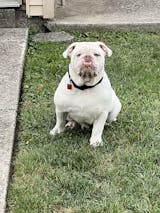Depression in Dogs: Signs, Causes, and How to Help
Just like people, dogs can experience feelings of sadness and depression. While they can't tell us what's wrong, their behavior can give us clues. Recognizing the signs of depression in your dog is crucial for ensuring their well-being. Understanding the causes and knowing how to help can make a big difference in getting your furry friend back to their happy self. Let's discover the reasons behind dog depression, and how you can help your furry friend feel better.

Signs of Depression in Dogs:
Dogs can’t tell us when they’re feeling sad, so it's important as dog owners to watch their behavior closely. Here are some signs that might indicate your dog is feeling depressed:
- Change in Appetite: If your dog suddenly starts eating less or more than usual, it could be a sign of depression.
- Lack of Interest in Activities: Dogs usually love to play and go for walks. If your dog is suddenly less interested in these activities, they might be feeling down.
- Sleep Changes: Dogs need sleep, but if your dog is sleeping much more or less than normal, it might be a sign of depression. Read more on the different causes behind the change in a dog's sleep schedule to help determine the root of the issue.
- Withdrawal: If your dog is hiding, avoiding interactions, or seems less responsive to you, this can often be a sign.
- Changes in Behavior: Look for any sudden changes in behavior, such as excessive barking or growling, which could indicate that something is wrong.
Causes of Depression in Dogs:
Just like with people, there are many reasons why a dog might become depressed. Understanding these causes can help you find the best way to support your furry friend:
- Change in Routine: Dogs are creatures of habit. A big change, like moving to a new house or changing their daily routine, can upset them and result in doggy gloom.
- Loss of a Companion: If your dog has lost a companion—whether another pet or a person they were close to—they might feel lonely and sad.
- Health Issues: Sometimes depression in dogs can be a sign of a health problem. If your dog is feeling down and you can’t figure out why, it may be time to take them to the vet to rule out any medical issues.
- Lack of Mental Stimulation: Dogs need mental exercise as well as physical exercise. If your dog is bored and not getting enough mental stimulation, it can lead to feelings of sadness.
- Trauma or Stress: Just like people, dogs can be affected by stress or trauma. A scary experience or a stressful environment can lead to depression in dogs.
How to Help Your Dog Feel Better:
If you think your dog might be depressed, there are several things you can do to help:
- Maintain a Routine: Try to keep your dog’s daily routine as consistent as possible. Regular feeding times, walks, and play sessions can help provide stability.
- Provide Comfort: Spend extra time with your dog. Cuddling, gentle petting, and talking to them can help reassure them that everything is okay.
- Engage in Activities: Make sure your dog gets enough physical and mental exercise. Play with them using their favorite toys, try new activities, and go on regular walks.
- Offer Socialization: If your dog is used to interacting with other dogs or people, try to arrange playdates or social activities to help them feel connected.
- Bond through Grooming Routines: One easy way to strengthen the bond with your pup is none other than establishing a daily grooming routine. Whether this involves using Squishface Nose Balm to hydrate their snout, Ear Wipes to keep their ears clean and wax-free, or a daily wipe down after outdoor adventures with Wrinkle Wipes, you can spend some much needed one-on-one time to help your dog feel loved and well-cared for.
The Bottom Line:
Remember, just like with people, helping a depressed dog takes time and patience. By understanding the signs and causes of dog depression and taking steps to support your furry friend, you can help them feel better and get back to their happy, tail wagging self. Your dog’s well-being is worth every effort, and with your love and care, they’ll know they’re never alone.










